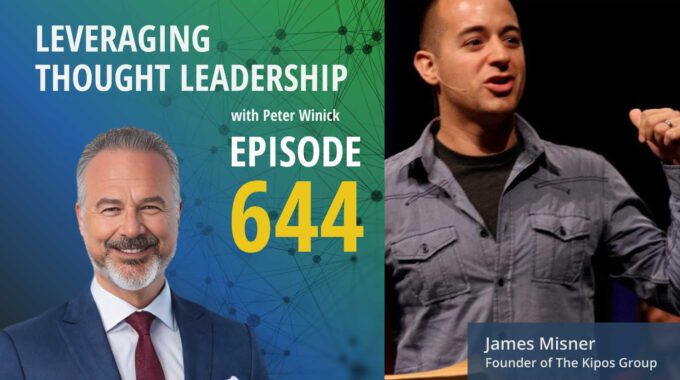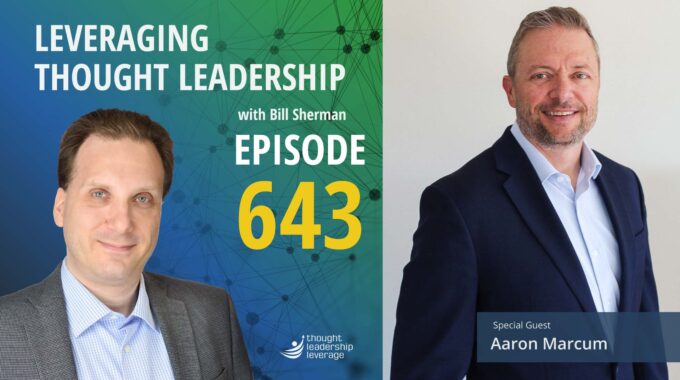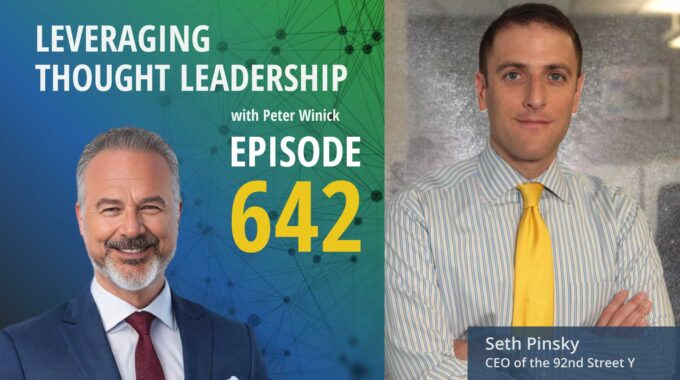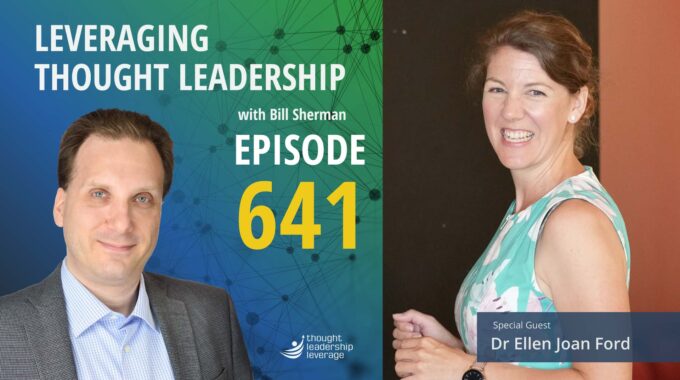The power of thought leadership in solving nonprofit fundraising challenges. Nonprofit organizations often struggle to…
Leveraging Thought Leadership With Peter Winick – Episode 126 – Daniel Blue
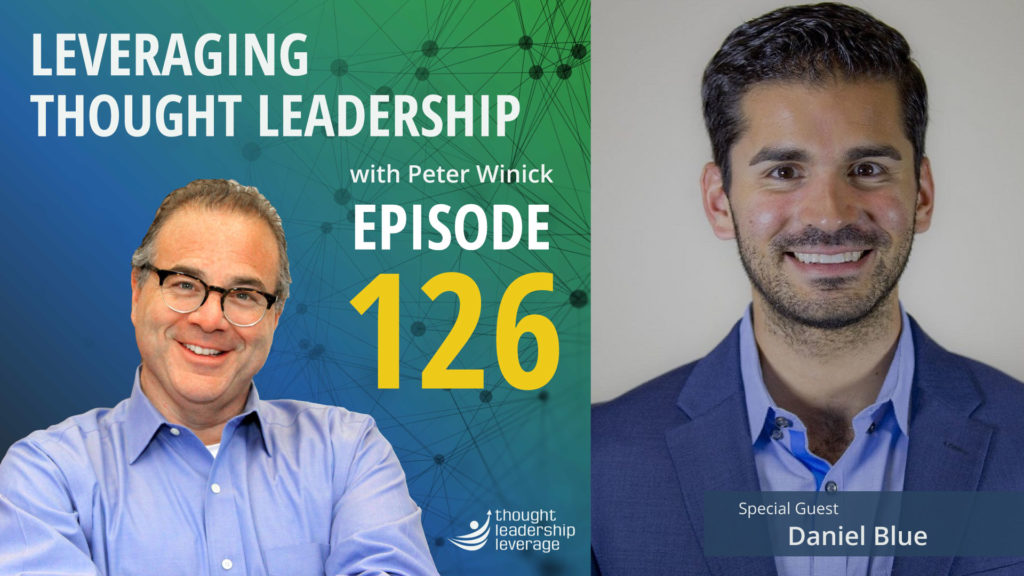
Today, we change lanes and speak with Daniel Blue, owner and founder of Quest Education, a company working across all 50 states to help business owners manage retirement funds.
Through his company, Daniel develops targeted content to educate clients about undiscovered options that provide even greater benefits, and speaks about the pressing financial issues of retirement in our modern world. He debunks some retirement fund myths, and offers tips and tricks for making your retirement better.
Daniel also offers advice about thought leadership, which social media platforms reach the biggest audience, and how to make truly effective video content. Listen in!
Daniel has had great success with video content. If you are thinking about making digital content check out our tips on the 3 Stages of Digital Content Creation.
If you need a strategy to bring your thought leadership to market, Thought Leadership Leverage can assist you! Contact us for more information. In addition, we can help you implement marketing, research, and sales. Let us help you so you can devote yourself to what you do best.
Transcript
Peter Winick And welcome, welcome, welcome. This is Peter Winick. I’m the founder and CEO of Thought Leadership Leverage. And you’re joining us on the podcast today, which is Leveraging Thought Leadership. Today, my guest is an interesting gentleman named Daniel Blue. Daniel’s got a really interesting probably better words for it than that background in that he was at one point an OxyContin addict. When he was 18 years old, he became a dad. So those two variables together are not necessarily ones that lead someone on a path to great success. But he was able to overcome a lot of issues, hit rock bottom, get himself clean, and when he hit 24, he sort of changed all that And where we are today, which is really interesting. We’ll get his story in a little bit, is he’s in the self-directed retirement account business. So then you say, well, what the heck does that have to do with what we typically talk about here around thought leadership? But he uses content and thought leadership to better serve and attract clients and make them aware of alternative financial investments they have. So, Daniel, welcome aboard.
Daniel Blue Hey, Peter, Appreciate you having me on the show.
Peter Winick My pleasure. So let’s just sort of dive right in. So you are your business is not the content business or the thought leadership business. Your business is serving your customers through financial services, is that right?
Daniel Blue Yes. We’ve got clients in all 50 states and we’ve got about 1200 customers as of today.
Peter Winick Very cool. And, you know, I think it’s a fair statement to say that financial services, like many businesses today, but particularly for financial services, has been commoditized to a large degree.
Daniel Blue Yeah, absolutely. We take a reverse approach. You know, there’s just tons of companies that just shove product down people’s throats and sell investments and commissions and underlying fees. And, you know, we’ve taken an opposite approach where we just try to solve problems. And the beauty of self-directed accounts as they can get really creative and solve a bunch of different problems.
Peter Winick Which is great. So the creativity comes in. I would suggest in two ways. One is the nature of your products are inherently creative and different, it seems to me. And we were chatting a little bit earlier that your sort of special sauce is developing and deploying very targeted and educational content for prospects and clients that teach them something and ultimately get them to want to learn more and talk to someone on your team to see if it’s a fit. So can you talk a little bit about how you make choices around developing content and where to deploy it and maybe a little bit on what the impact of that is? Because I imagine you’re a finance guy. There’s probably a good ROI on this for you.
Daniel Blue Yeah, absolutely. We’re super blessed to be where we are today. We got ranked by Inc. 5000 is one of the fastest growing companies. Last year we got ranked number 286. So super fortunate to have I a team in. Thanks. So really we just reverse engineered it. What are problems that people have a couple of problems. Number one debt. There’s a lot of people out there that are paying ten, 15, 20% interest on debt, like credit card debt. That’s one problem. Another problem is the lack of capital, right? Yeah. The economy’s been doing well over the last seven, eight, nine years since the Great Recession. So there’s a lot of entrepreneurs out there. And when you’re a business owner, you need capital. You need business funding. Yep, we know that’s an issue. And then there’s a lot of people out there that are just tired of the stock market where they’re invested in these mutual funds with a bunch of fees and they have no control over their money and they’re only limited to an IRA where they can only put in 6000 a year. So, you know, we just looked at those problems and we thought, you know, let’s are business owners because the IRS allows business owners a specific type of retirement account that’s called a solo for one K.
Peter Winick So let me let me pause you there for a second without getting too technical. So what I want to make clear is you have a very, very specific client avatar and a very, very specific problem that you solve. So business owners, because of the tax laws and such. So that means you’re not wasting your energy, your resources, your marketing effort on everybody. You know, it seems like the big financial houses is their model is most folks can open an account for something or they open up your local bank all opening an IRA for you. But because of the your understanding of the tax code, business owners or specific audience, can you drill a little further on terms of the client avatars? Because it all comes together in terms of the problem that you solve, who you’re focusing on, and then how you create the content to support them? So other avatars besides business owners, or is that your primary focus?
Daniel Blue I know that that’s just the way the iris code, as you alluded to, is set up. If you’re just an individual straight W2 employee, no side business, no intention on setting up a business, you’re pretty limited in the retirement account arena. So they serve business owners.
Peter Winick So and is there any like one? Because now we drill that down. Okay, business owners, are there different subsets of that market? They’re more attractive to you family. Own business. A business of a certain size. Industry. Geography. How do you now go into the business owner pond and fish with content?
Daniel Blue You know, we’ve had a lot of success and it’s interesting to see how it came about. But we’ve had a lot of success in California, Texas and Florida. As I mentioned earlier, we’ve got customers in all 50 states, but that’s where we have a lot of our customers. And, you know, we’ve got different types of business owners, right? I’ve got business owners that have an e-commerce store, an Amazon business, dropshipping I’ve got customers that own turf businesses, restaurants, construction businesses. So, you know, I think it really just comes down to, you know, what problem they’re facing because the bigger companies, they still need funding. They might have debt, they might want to do real estate investment. So really just comes down to what they’re looking for.
Peter Winick Okay. So now let’s sort of put the pieces together. The solution to a problem that you have are these self-directed retirement plans that most people I mean, I’m a business owner weren’t aware of that. That’s a thing. Right. So there’s an educational phase to your sales cycle where the burden is on you to educate me as a business owner to say, Hey, here’s something that you have to consider that you may or may not know about. Let me teach you that, right? So, you know, and ultimately, success for you is to serve your clients and find new clients and get new assets under management. So how let’s shift to the content creation mode, because now we know what we’re telling them. We know who we’re selling to. How do you go about effectively developing and deploying content that resonates with that group that gets them to raise their hand for some level of action?
Daniel Blue So the really, you know, before we even do business with the customer and move forward, you know, there’s definitely a series of phone calls that take place with my team and we just pretty much peel back, you know, pull back the curtain and share everything. No, no hidden agenda. We just give.
Peter Winick No, but let’s go for the phone call. So I want to even take it. Let’s go. Because once we hit the phone call, we’re on the sales side of the equation. I want to talk about the content because you got a lot of good stuff out there from a marketing side where you’re targeting me with content as a business owner in ways that get me thinking about that. That’s what I want to focus on that for a minute, if we could.
Daniel Blue Got you. Well, what’s interesting about that, Peter, is we were a dinosaur last year. We had no digital marketing, no videos. If you look at some of my first videos, you know, I’m embarrassed to even look at them. I laugh and cringe at the same time. So we had no digital presence. Everything that we did was on a referral based business model. You know, I’d get data from CPA firms, real estate companies, things of that nature. So last year I had an epiphany where I thought, you know, we just got ranked by 85,000. I don’t even have social media. We’re not doing any content creation. If I don’t jump on the technology side and start doing video because video has a great way of reaching people, I’m going to get lost behind. So now it’s just been in full video mode. We do tons of videos.
Peter Winick So let’s talk about yeah, let’s so let’s spend because I think a lot of people video is incredibly powerful across many of the social media platforms. But a lot of people get scared and, you know, they either they don’t know how to do it. They’re afraid. They don’t like what they look like. Is it is it professional enough? Is it too professional to walk me through all of those choices until because I believe, based on what I’ve looked at, you sort of found your lane and your voice and a style and things that are now I don’t want to say it’s easier, but you sort of found your lane in your comfort zone inside this video world. Tell us about that journey a little bit.
Daniel Blue Well, it’s funny that you say all those things as far as those are excuses why people don’t do videos. I started battle with that. Yup. You know, I don’t like how I sound. I don’t like the way I look, what I’m going to talk about. So again, I just took it back to the sales side. What are the problems people are facing? I just wrote down all of the objections I would get from people, top questions I’d get from people, biggest problems people would face. And you’d be surprised if you no matter what business you’re in, if you just list all of those objections, questions that people have pertaining to that arena, you’re going to have tons of material written down. And each one of those bullet points, there’s going to be tons of video that you can do within those bullet points.
Peter Winick So I love that. So is it as simple as I mean, you’ve been in your business for a while, asking your sales team and yourself is, hey, let’s spend a half an hour. What are the top ten reasons that resistance we have to overcome with clients or reasons we don’t get them? Like let’s just because you know what they are. You have the institutional knowledge, okay? And they say, Great. Okay. So if one piece here is, I don’t know, this sounds different. Like, give me an example of what one of those resisters is. Yeah.
Daniel Blue I mean, I don’t want to touch my retirement account because I’m going to pay penalties and taxes.
Peter Winick Okay. So that’s a fallacy. So there’s a mis belief that, I’ve got all this money in A41K IRA if I do anything with it. I read an article once on a magazine. They’re going to pay all these penalties. Right? But now you can debunk that myth with video content. So can you give examples of that? Because that’s really a myth. Debunker, right? How do you how do you go about attacking them?
Daniel Blue Yeah. So I mean, that specific topic, I can do 3 or 4 videos on that topic. I can do a topic on, hey, if you have a. Or one came from a previous employer that was collecting dust. You can roll it over into a solo for one K, tap into it without paying penalties and taxes. That’s one video. Or maybe they have an I.R.A. and they’re going to take a distribution and get penalized and taxed. Yes, that’s correct. But you could roll that IRA into a solo for one K and not pay the penalties and taxes. So you could really break it down because these videos that you do, we know people don’t watch videos. I don’t watch videos for more than a couple of minutes unless I’m super, super, super interested. So I’m only going to get a minute or two of their time. So when we do videos, we purposely only create these videos to be 60s 90s maybe a couple minutes tops. So knowing that they’re going to be short videos, we can really break it down and have a bunch of content just from one topic.
Peter Winick Well, and that duration is the I mean, the last research I did is it went from like, you know, high two minutes to about a minute, 20-minute 30s, the sweet spot. So instead of, you know, there’s probably lots that you can say on that topic but chunking them out into, you know, six one minute units as opposed to one six minute unit is a better plan. So, okay, so we know what our problems are and we know that we can create short videos that are punchy, that are informative, that in your case, you know, there’s an educational piece to it. Now the next thing is, and I think this is the second place people stumble once you get over, I don’t like what I look like and you know, all that sort of stuff is, okay, what do I do with these? Where the heck do I put them so that they get in front of the right people to get the right reaction? So can you touch on that for a little bit?
Daniel Blue Yeah. So, you know, I’ve had a lot of success on Facebook, you know, just my personal page, a little back story. I didn’t have social media last year. I jumped on Facebook the very first time in about Q3 of last year.
Peter Winick So definitely late to the dance.
Daniel Blue Yeah. Yeah. So I started with, you know, one friend in Q3 and I made it a point to network and, you know, have friends on Facebook with people that were like minded business owners, people that I could give value to, people that could give value to me, really just, you know, helping each other out in different ways. And, you know, now I’ve got you know, I think the last time I checked, about 1300 friends. But these aren’t my high school friends. These aren’t my parents, you know, these are real people. And I just make it a point to do as much videos as I can. But again, I don’t do a video every single day and posts that people are going to get tired of that. So I’ve got to keep it, you know, keep it interesting and mix it up.
Peter Winick So it’s interesting. And this is what I love about using content and thought leadership from a marketing perspective is that there is no one universal law, right? So everybody says, but you know, LinkedIn is more of a corporate, more of a business, more of a professional place. And that is true. But, you know, I would not have guessed that you’re going to find business owners to have discussions around their retirement investment on Facebook. So, like, how did how did you choose Facebook or how did you learn that that is a place where you can get in touch with the right people in the right way? Because again, there’s no formula for this.
Daniel Blue Yeah. So, you know, we looked at our, you know, before we did social media last year, we looked at our existing customers and we found that, again, in California, Texas and Florida. A lot of them are there. They’re between the ages of 40 and 60. Okay. So I thought, okay, I’m not going to touch Instagram for right now because I just don’t feel that it’s my demographic and I like LinkedIn, but I just felt like I could have a little bit more control on Facebook. I did research on Facebook groups, had a lot of great success in Facebook group, and I just felt that Facebook was just out of the two between Lincoln and Facebook. I thought, you know, since I’m a newbie on social media, let me just really, really focus on one channel and try to get as good as I can get. And, you know, Facebook is worked out. You know, I’ll do a video and they might not like or comment my video, but they’ll do me. Hey, here’s a question for you. Hey, can you do it on a phone call?
Peter Winick So, so interesting. So one is so there’s a couple of things that you said there that I think that are I think are important. You did some homework. You did some research that gave you an inkling that this is probably where they are via the groups, etc.. And then you spent some time there, because I think what happens often and I’ve seen this with lots of others is, well, I’m going to go try this, this Instagram thing for a month, and then I’m gonna go over to Twitter for three. You know, they’re sort of nibbling at the buffet of all of social. And I think it is important to pick, find the right social media platforms and be there for a while and make those investments and be consistent. Right. Because you’re not going to get someone the first time you pop up a video to call you and say, and here’s $1 million I have in my retirement account. Thanks for that video. It was really it was really thoughtful. Right? They want to see you. They want to know that you’re there. So can you talk about sort of the consistency and then maybe touch on other platforms that you’ve experimented with, whether they’ve worked or not?
Daniel Blue Yeah. No, I it’s a really good question. One of my mentors, he said, Hey, look, it’s going to take about six months of you consistently posting, consistently being there, being in front of them for them to know, like and trust you, right? And you just got to stay with it. And sure enough, about six months into it, that’s when I started to see results.
Peter Winick But how many times during that six months, you’re like, jeez, another video. It’s been four months. You know.
Daniel Blue I was tired, especially when I was still trying to find my lane and get comfortable in front of a camera. And look, I might look comfortable in front of a camera now, but that’s not always the case. I have a secret weapon I pull out sometimes before I jump on camera or bust out, like 20 pushups. Yeah. Let me get some blood flow in. Let me get some excitement going and then let me act into a different character. Because on video, you have to be someone else. You have to be more enthusiastic. But I think one thing that a lot of people forget is people don’t go on Facebook to do business. People go on Facebook for the purpose. They’re bored. They want to write rhyme. And if you can get their attention and talk about something that’s interesting, then it goes into business. And, you know, I think people forget about that is, you know, you’re shopping with your wife at Lowe’s or, you know, Bed Bath and Beyond. And while she’s at the checkbook checkout, you’re on Facebook just scrolling through your feed. Right. You know, so if you can grab their attention and then stay, like you said earlier, they’re not going to reach out to me after one video. But if I can stay consistently in front of them and have some personal content as well so they can get to know me as a person because no matter how much value I bring to the table, they have to know that I’m someone that’s real, someone that they can relate to, they can relate to me. They’re not going to want to do business no matter how much good content I put out there. So I think it’s a combination of being relatable, you know, being transparent and who I am and where I come from and what my life’s about, and then sprinkle in some business content. So I use I use a formula. It’s about out of every ten posts, buy 2 or 3 of them are business related. The rest is not.
Peter Winick Got it. So lots to unpack there in terms of that consistency, in terms of showing up, the fact that, you know, you’re winning when they’re hanging. Right. You know, I agree with you people that why are people on Facebook? Lots of reasons. Boredom is probably a primary one, staying connected, etc.. But I don’t know, you know, now that I’m sort of processing what you do and how you do it. I’m a business owner. I’ve got retirement funds, etc. I’ve never gone and I’m on Facebook, but I don’t go on Facebook thinking, you know, what might I do differently with my retirement fund? So it’s interesting that you busted through all the noise, right? There’s tons of cat videos and, you know, I can find out what all my friends are having for lunch, like all that sort of brainless type stuff. But I think the fact that there’s something really poignant and relevant to what you’re saying to the right group that can help you break through that noise. I love that. I think that’s very cool. So as we start to wrap up here, give some advice to someone that’s out there and it doesn’t matter if they’re in the financial services business like you, leadership development, it doesn’t matter, right? Because I love the bravery that you’ve had diving into this thing in the last 18 months or so. What would you tell people to do if they were going to get started and what would you tell them to not do?
Daniel Blue Get started in social media and content creation like we’ve been talking about?
Peter Winick Yeah, yeah, yeah. Like, yeah, exactly.
Daniel Blue So I think you need to take a step back and write down who you are, you know, what are your core values, what do you represent and who your audience is. And, and just know that it’s not going to happen overnight. I truly believe it’s going to take six months at least, for people to know, like and trust you before you start to get results. So you really have to be in the mind frame to play the long game so you can’t quit patience patiently.
Peter Winick Patience.
Daniel Blue Exactly. And we live in a world where we want instant gratification and we want a bunch of likes, a bunch of comments. We want results. But it’s just it’s not going to happen. So you can’t give up and you have to be consistent. I had problems posting every day. You know, one of my mentors was like, Hey, man, you got to post every day. I’m like, What am I going to post about every day? Like, I’m not going to post.
Peter Winick I have nothing.
Daniel Blue Say, I’m not going to post a picture of my phone. I don’t know what to say, so don’t post just the post if you’re going to post. There has to be intent behind your post. There’s got to be some type of value you’re bringing to the table. Value can be entertainment. It could be inspirational. People love an underdog story. It can be educational. So you got to spread the love.
Peter Winick But it also needs to be consistent. I love what you said, where the lazy path would be. Well, two days a week I’m going to do my homework and post things that are relevant to the business objectives that I have, but then I’m going to get lazy and talk about my tuna sandwich, right? Yeah, because then eventually, very shortly, people got to go, This guy is inconsistent. This guy is not worth my time. Exactly. I don’t know what he’s talking about. I got I’m going to go over there and know that when I tune into the Daniel Channel, this is the type of information I’m getting.
Daniel Blue That I’m really glad you brought that up because that’s I think this is a nugget for your audience is look at your social media as a TV channel. All right. We can go to all of these different channels on TV. And there’s people out there that are diehard Comedy Central followers. Yeah. You know, die hard Fox News. Right. Yeah. That’s because they gravitate towards that channel. That channel keeps them hooked in. So you have to keep your channel consistent. You got to mix it up and keep them from going to watch somebody else. Because if it’s not you, they’re going to watch somebody else.
Peter Winick Yeah. And their attention spans are not getting longer. So anyway, I appreciate all that you’ve shared with us today, because know, when you and I were talking about getting on the show, I’m like, that’s a little bit different. But I love the journey that you’ve been on, and I think there’s so much that we could all learn from what you’ve done, even though most of the folks listening today are not in the financial services business, the path that you’ve taken and the consistency and the discussion of specific problems to a specific audience are all things that we work on with our clients. So I appreciate your willingness to come on and share your journey with us. Daniel, thank you so much.
Daniel Blue Hey, I appreciate that. For the people that are not doing video that are on the edge of doing video, if you’re not doing video, someone else is. And it’s your duty to bring your knowledge to the forefront so other people can get your knowledge. So thank you for having me, Peter.
Peter Winick My pleasure. Thanks so much. To learn more about Thought Leadership Leverage, please visit our Web site at ThoughtLeadershipLeverage.com to reach me directly. Feel free to email me at Peter at ThoughtLeadershipLeverage.com. And please subscribe to Leveraging Thought Leadership on iTunes or your favorite podcast app to get your weekly episode automatically.


